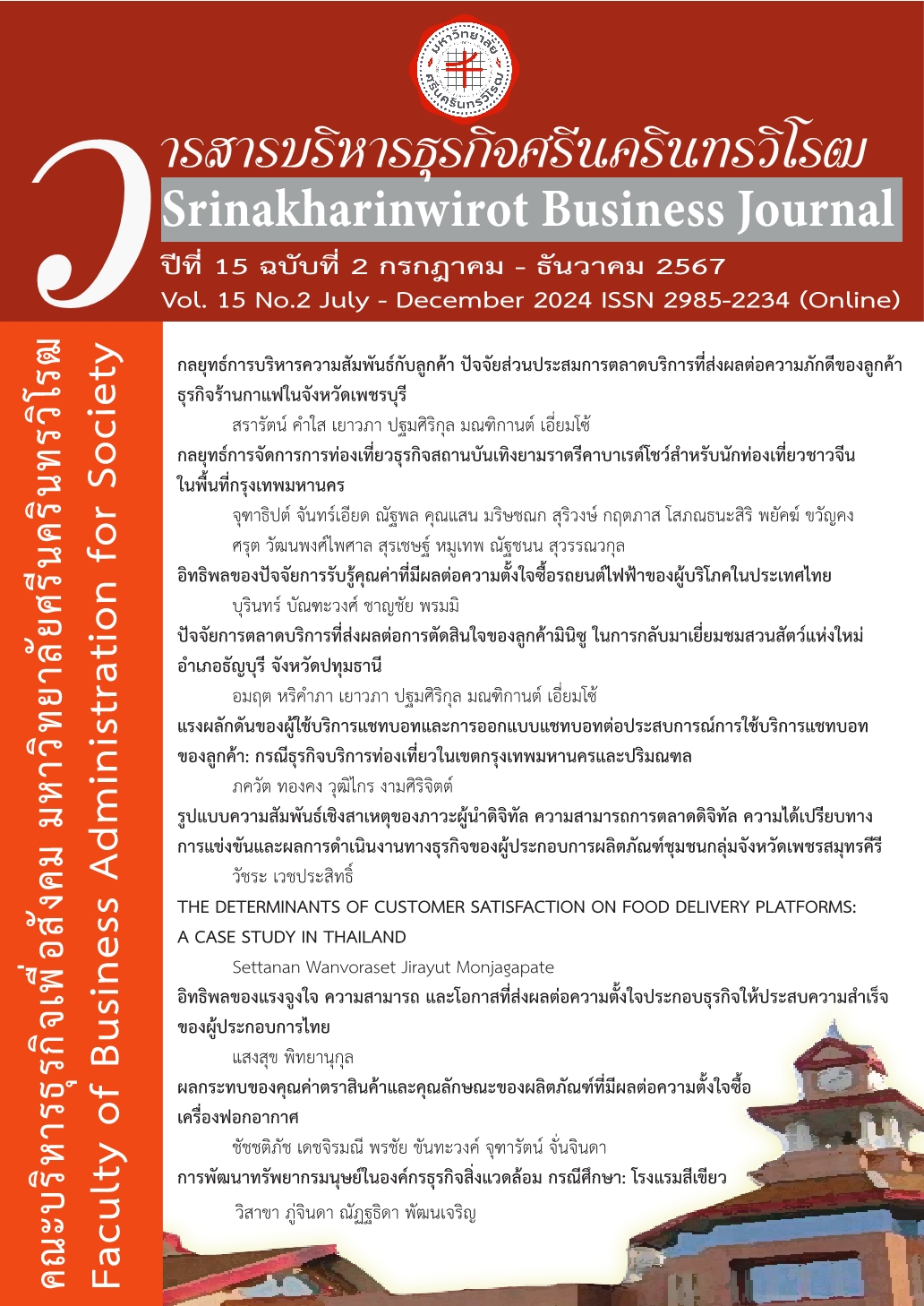STRATEGIES FOR MANAGING NIGHT ENTERTAINMENT CABARET SHOW TOURISM BUSINESSES FOR CHINESE TOURISTS IN THE BANGKOK AREA
กลยุทธ์การจัดการการท่องเที่ยวธุรกิจสถานบันเทิงยามราตรี คาบาเรต์โชว์สำหรับนักท่องเที่ยวชาวจีนในพื้นที่กรุงเทพมหานคร
Keywords:
Management, Cabaret show, Chinese touristsAbstract
Strategies for managing nightlife cabaret show tourism for Chinese tourists in Bangkok. This study focuses on analyzing and developing marketing strategies for Chinese tourists visiting cabaret shows in Bangkok. The aim is to enhance the accessibility and attractiveness of the shows, thereby increasing the competitiveness of the cabaret show tourism industry. The research objectives are 1) To study the motivations and satisfaction levels of Chinese tourists who attend cabaret shows in Bangkok, 2) To evaluate the management potential of nightlife cabaret show tourism in Bangkok, and 3) To develop management strategies for the night entertainment cabaret show business in Bangkok. The research methodology includes qualitative data analysis using content analysis, SWOT analysis, and TOWS matrix. Quantitative data analysis uses descriptive statistics such as percentages, means, frequencies, and standard deviations. The findings indicate that most Chinese tourists are male, aged between 28-43 years. The average motivation score for Chinese tourists visiting cabaret shows in Bangkok is ( = 3.85, S.D. = 0.50), and the average satisfaction score is ( = 3.97, S.D. = 0.46). Tourists value memorable experiences and quality service. Therefore, key marketing strategies include improving show quality, setting appropriate prices, using online channels for promotion, and effective personnel management. From both quantitative and qualitative analysis, the researcher identified crucial strategies for managing night entertainment cabaret show tourism for Chinese tourists in Bangkok, which include product management strategies, pricing strategies, sales and marketing promotion strategies, personnel management, physical characteristics management strategies, and business process strategies. The study results highlight the importance of improving the quality of performances and services to enhance the satisfaction and motivation of Chinese tourists. Using online channels for promotion and setting appropriate prices are key strategies for attracting tourists. Additionally, effective personnel management and the physical management of the venue are crucial factors that contribute to creating a positive experience for tourists and enhancing the competitive edge of cabaret show businesses in Bangkok.Downloads
References
กฤติกา คุณูปการ และเกศรา สุกเพชร. (2565). ปัจจัยความสัมพันธ์เชิงสาเหตุที่ส่งผลต่อความภักดีของ
นักท่องเที่ยวชาวจีนมูลค่าสูงที่มีต่อภาคใต้ของประเทศไทย. วารสารวิชาการมหาวิทยาลัยหอการค้าไทย มนุษยศาสตร์และสังคมศาสตร์. 42(3), 78 – 103.
https://utcc2.utcc.ac.th/utccjournal/journal_book.php?journal_id=72
กองเศรษฐกิจการท่องเที่ยวและกีฬา. (2567). รายงานสรุปดัชนีการพัฒนาการเดินทางและการท่องเที่ยว ปี 2567 (2024). กรุงเทพฯ: กระทรวงการท่องเที่ยวและกีฬา.
กรมส่งเสริมการค้าระหว่างประเทศ. (2566). ประเทศไทย จุดมุ่งหมายของนักท่องเที่ยวชาวจีน. ค้นเมื่อ 21
มีนาคม 2567, จาก https://shorturl.asia/QwfDX
ชัย วัชรงค์. (2566). นักท่องเที่ยวต่างชาติ เที่ยวในประเทศไทยปี 2566. กรมประชาสัมพันธ์. ค้นเมื่อ 21 มีนาคม 2567, จาก https://shorturl.asia/FjTim
จันทิมา ริ้วทองชุ่ม. (2562). พฤติกรรมการท่องเที่ยวของนักท่องเที่ยวชาวต่างชาติที่เดินทางมาท่องเที่ยวยามราตรีในเขตกรุงเทพมหานคร. ใน ดวงสมร รุ่งสวรรค์โพธิ์ (บ.ก), การประชุมวิชาการและนำเสนอผลงานวิจัยระดับชาติและนานาชาติ ครั้งที่ 10. Global Goals, Local Actions: Looking Back and Moving Forward (น. 690-698). มหาวิทยาลัยราชภัฏสวนสุนันทา.
ณัชชารีย์ ธนาเลิศวสุนนท์. (2563). การพัฒนาภาพลักษณ์เชิงการตระหนักรู้และภาพลักษณ์เชิงความรู้สึกของ
นักท่องเที่ยวที่บ่งชี้ภาพลักษณ์ของแหล่งท่องเที่ยวยามค่ำคืน กรณีศึกษา เมืองพัทยา จังหวัดชลบุรี. วารสารวิชาการ มหาวิทยาลัยการจัดการและเทคโนโลยีอีสเทิร์น, 17(1), 1-10. https://so06.tci- thaijo.org/index.php/umt-poly/article/view/241665/164551
ประสิทธิ์ ทองอุ่น. (2542). พฤติกรรมมนุษย์กับการพัฒนาตน. เธิร์ดเวฟ เอ็ดดูเคชั่น.
ภัทร์ธนกัลย์ เตี่ยไพบูลย์. (2557). ศักยภาพแหล่งท่องเที่ยวเชิงนิเวศโดยชุมชน บ้านหัวนอนวัด ตำบลแม่ทอม
อำเภอบางกล่ำ จังหวัดสงขลา. มหาวิทยาลัยสงขลานครินทร์.
รัชติยาพร อภิวรรณรัตน์, ทรงพร อ่อนนาเรนทร์, และ ภูริวัจน์ เดชอุ่ม. (2560). รูปแบบการมีส่วนร่วมในการ
จัดการท่องเที่ยวยามค่ำคืนของเกาะรัตนโกสินทร์. ค้นเมื่อ 21 มีนาคม 2567, จาก
https://kukr.lib.ku.ac.th/kukr_es/kukr/search_detail/result/20005218
สวัสดีไทยแลนด์. (2565). Thailand Aims to Attract 5 Million Chinese Tourists in 2023. ค้นเมื่อ
มิถุนายน 2567, จาก https://www.thailand.go.th/issue-focus-detail/001_02_339
สุภางค์ จันทวานิช. (2549). วิธีการวิจัยเชิงคุณภาพ. กรุงเทพฯ: จุฬาลงกรณ์มหาวิทยาลัย.
สุภางค์ จันทวานิช. (2553). วิธีการวิจัยเชิงคุณภาพ (พิมพ์ครั้งที่ 18). กรุงเทพฯ: สำนักพิมพ์แห่งจุฬาลงกรณ์
มหาวิทยาลัย.
สุไรดา กาซอ. (2561). แนวทางการจัดการการท่องเที่ยว พื้นที่ตำบลทุ่งหว้า อำเภอทุ่งหว้า จังหวัดสตูล. ค้นเมื่อ 16 มิถุนายน 2567, จาก http://repository.nida.ac.th/handle/662723737/4471
เฉลิมเกียรติ ตุ่นแก้ว. (2553). ความพึงพอใจของผู้ปกครองที่มีต่อการบริหารงานโรงเรียนสาธิตมหาวิทยาลัยราชภัฏเชียงราย. [วิทยานิพนธ์ ปริญญามหาบัณฑิต ไม่ได้ตีพิมพ์]. มหาวิทยาลัยราชภัฏเชียงราย.
วิชัย สวัสดิ์จีน. (2561). บทบาทนางโชว์ในโรงละครคาบาเรต์. Chulalongkorn University Theses and
Dissertations (Chula ETD). ค้นเมื่อ 16 มิถุนายน 2567, จาก
https://digital.car.chula.ac.th/chulaetd/2953
ยุทธศักดิ์ สุภสร. (2566). ธุรกิจท่องเที่ยว. ฐานเศรษฐกิจ. ค้นเมื่อ 16 มิถุนายน 2567, จาก
https://www.thansettakij.com/business/tourism/602075
Cochran, W. G. (1977). Sampling Techniques (3rd ed.). New York: John Wiley and Sons.
Flick, U. (1998). An Introduction to Qualitative Research: Theory, Method and Applications. London:
Sage.
Kotler, P. (2000). Marketing Management. Northwestern University. The Millennium Edition: Prentice Hall International, Inc.
McIntosh, R. W., & Goeldner, C. R. (1986). Tourism: Principles, Practices, Philosophies. New York:
Wiley Press.
Miles, M. B., & Huberman, A. M. (1994). Qualitative data analysis: An expanded sourcebook (2nd ed.). Sage Publications, Inc.
Nastasi, B. K., & Schensul, S. L. (2005). Contributions of qualitative research to the validity of
intervention research. Journal of School Psychology, 43(3), 177-195.
Ni, J., Rhim, A.H.R., Chiu, D.K.W. and Ho, K.K.W. (2022). Information search behavior among Chinese self-drive tourists in the smartphone era. Information Discovery and Delivery. 50(3), 285-296.
Onwuegbuzie, A., & Leech, N. L. (2007). Sampling Designs in Qualitative Research: Making the
Sampling Process More Public. The Qualitative Report, 12(2), 238-254.
https://nsuworks.nova.edu/tqr/vol12/iss2/7/
Philip. (1997). Marketing management: analysis, planning, implementation, and control. 9th ed. New
Jersey: A Simon & Schuster Company.
Pike, S. (2008). Destination Marketing: An integrated marketing communication approach. Butterworth- Heinemann.
Schiffman, L. G., & Kanuk, L. L. (1994). Consumer Behavior (5th ed.). New Jersey: Prentice-Hall.
Soojin Choi. (2005). Information search behavior of Chinese leisure travelers.
https://docs.lib.purdue.edu/dissertations/AAI3251601/
Stanton, W. J. (1981). Fundamentals of Marketing. New York: McGraw-Hill.
Downloads
Published
How to Cite
Issue
Section
License
Copyright (c) 2024 วารสารบริหารธุรกิจศรีนครินทรวิโรฒ: Srinakharinwirot Business Journal

This work is licensed under a Creative Commons Attribution-NonCommercial-NoDerivatives 4.0 International License.
วารสารบริหารธุรกิจศรีนครินทรวิโรฒ ยินดีรับบทความวิจัยและบทความทางวิชาการด้านบริหารธุรกิจ เพื่อพิจารณาตีพิมพ์เผยแพร่ในวารสาร ซึ่งทัศนะและข้อคิดเห็นใดๆ ในวารสารฯ ถือเป็นความคิดเห็นและความรับผิดชอบโดยตรงของผู้เขียน มิใช่เป็นความคิดเห็นและความรับผิดชอบใดๆ ของคณะบริหารธุรกิจเพื่อสังคม มหาวิทยาลัยศรีนครินทรวิโรฒ ผู้ประสงค์จะนำบทความหรือบทวิจารณ์ใดๆ ไปเผยแพร่ จะต้องได้รับการอนุญาตจากวารสารเป็นลายลักษณ์อักษร ลิขสิทธิ์บทความที่เผยแพร่ทั้งหมดเป็นของวารสารบริหารธุรกิจศรีนครินทรวิโรฒ






